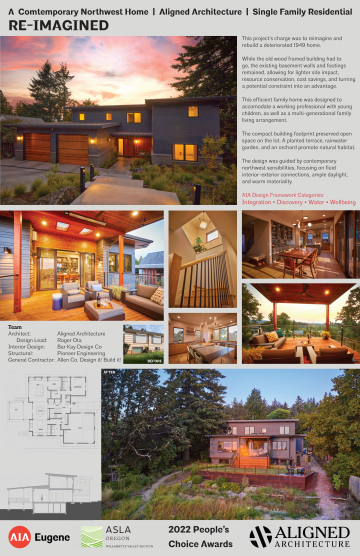1st place, Single-Family Residential Category
Featuring: Westview residence
This annual competition is organized by the American Institute of Architects Eugene Chapter during the month of September, where local architects and landscape architects present their featured projects in various categories, and the citizens of Eugene cast their vote for the best project in each category.
Project
Westview Residence
Eugene, Oregon
Architect
Roger Ota
Structural Engineer
Pioneer Engineering
General Contactor
Allen Co. Design it! Build it!
Photos
Steve Smith Photography
CONCEPTS
This thoughtfully planned project was a complete reconstruction of a deteriorated 1949 home. To conserve resources the existing basement walls and footings remained, allowing lighter site impact, cost savings, and turning a potential constraint into an advantage. The design priorities included light, warmth, Pacific Northwest sensibility and integration with the outdoors.
AIA CRITERIA
- Design for Integration
This efficient family home was designed to accommodate a working professional with young children, as well as a multi-generational family living arrangement, with guests staying for extended periods. The compact building footprint (living areas stacked on three floors) preserved open space on the lot. A planted terrace, rainwater garden, and an orchard promote natural habitat for both flora and fauna.
- Design for Discovery
The client wanted a design that would integrate the house with the landscape and make it as easy to enjoy the outside of the home as it did the inside. That meant an abundance of windows and natural light, common spaces that are inviting and outdoor spaces that expand the home’s interior spaces.
There is a simultaneous clarity and playfulness to the configuration of living, storage, and utility spaces over the three floor levels, supporting a variety of views and uses. Every cubic foot of space was carefully considered and utilized. A small wine cellar was built within the existing basement walls, and storage areas were fitted beneath the stairs and within the thick walls.
- Design for Water
The project incorporates water conservation and a responsible storm water management strategy. The long, sloped city lot offered the opportunity to create an on-site rainwater treatment and destination facility, reducing the load on the city storm water system. In collaboration with a landscape architect, the site is designed to prioritize low-maintenance landscape and water efficiency. Several native and drought-tolerant plant species cover the site. Impermeable surfaces were limited to the driveway and the entry path, leaving the majority of the site to absorb and recharge rainwater into the soil. Inside, an on-demand water heating system eliminates wasted water while waiting for hot water.
View original article

